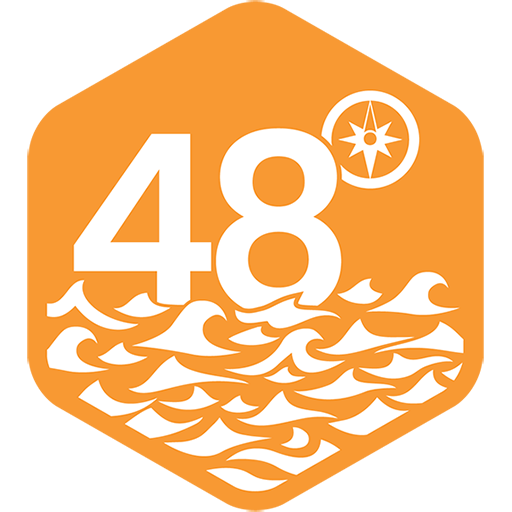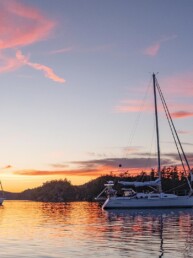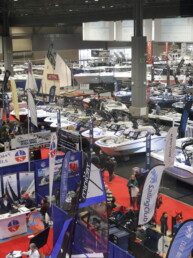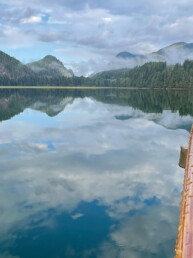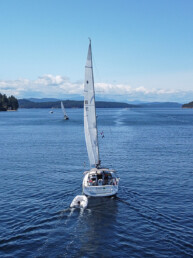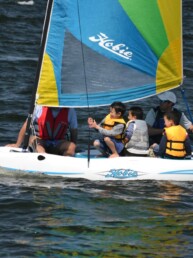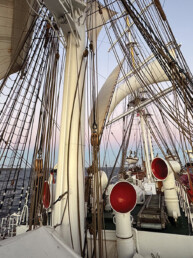New cruisers test their boat and skills with a voyage out the Strait of Juan de Fuca
The engine’s bass vibrations rumbled below me as I laid on the teak planks of the cockpit. The sun was out, the dodger blocked our apparent wind, and I was taking the opportunity to sunbathe in the late spring calm after many blustery and overcast days. Motoring our way west out of the Strait of Juan De Fuca, we’d just spent a rolly night at anchor in Thrasher Cove, the last protected anchorage on southern Vancouver Island before hitting the mouth of the Strait.
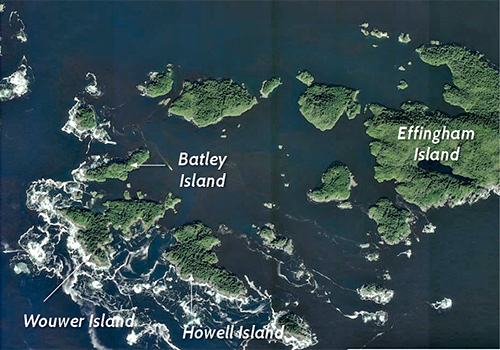
Our destination was Barkley Sound or as far as we could make it—maybe the outer Broken Group or possibly all the way into Ucluelet if we had enough daylight. It was early June and the days were long, but our Nicholson 32, Aeoli, is not a speedster. She is a solid 1960s fiberglass boat with a full keel and 13,000 pounds of lead ballast. We were happy to be chugging along at around four knots against a slight incoming tide and the long, smooth rollers pushing their way in off the ocean. We estimated that the 40 mile trip would take us at least 12 hours.
NOAA and the Canadian Weather Service told us to expect light and variable winds in the morning, with the breeze picking up through the afternoon. Using the motor is unusual for us. As new boat owners—one of us (me) a complete novice, and the other drawing on teenage experience lake sailing—we’re stubborn about pushing ourselves to stick to sails as much as possible. That approach had made for some very slow spring sailing around the San Juan Islands, as we found ourselves in wind holes, just a mile from some harbor entrance that was tantalizingly out of reach.
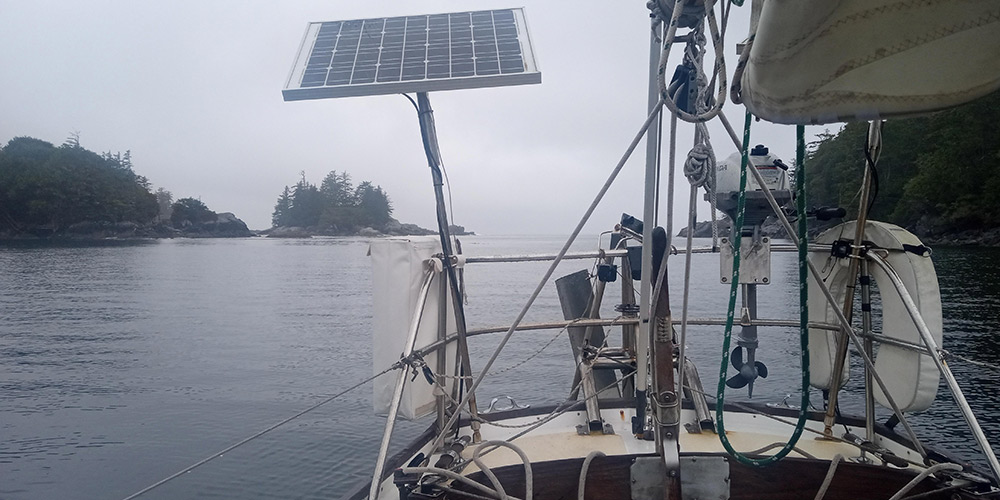
On this particular morning, we caved and fired up our little-used engine. We hadn’t learned to trust it yet, and maybe we shouldn’t ever get too comfortable. Every time we turn it on I worry that it’ll sputter out of breath and leave us drifting, pulled along by the powerful tides muscling along this rocky shoreline.
We’d taken our time exploring the Gulf Islands and spent several days in the unexpectedly wonderful Becher Bay, east of Sooke, hiking many miles of the regional park abutting the anchorage. Our decent weather was about to run out, though, and we’d found ourselves in a bit of a time crunch. A late-season atmospheric river was forecast to hit the coast the following day and we wanted to make it to Ucluelet for the brunt of the rain. Without a heater or shower on board, the pull of comforts at the marina was strong.
Every time we passed through a patch of wind, ripples gaining definition in the smooth blue expanse around us, I turned to Victor and asked, “Should we try sailing?” We pondered the question for a few minutes, squinting at the waves, sticking our heads over the side decks, trying to feel the difference between our apparent wind and the longed-for afternoon breeze. I knew that we should be grateful for the smooth trip down the Strait due to cautionary tales from fellow cruisers and notes in our old copy of the Waggoner guide, but it’s just plain boring sitting around burning diesel to get somewhere.
After two false starts—pulling the jib out, shifting into neutral, watching the sail fill lazily then collapse—we finally had enough wind to move us along at two to three knots. The rest of the afternoon passed while the intensely green shoreline slowly slid past. We spotted whales diving and surfacing, close enough to smell their fishy sighs and blows. The clouds began to blot out the sun and it soon became time to put on thermal layers and drysuits again. We could see the grey wall of fog looming ahead of us, marking the end of the protected waters of the Strait. By this point, it was nearly 5 p.m. and we still hadn’t made it even with Cape Beale, which marks the southern extent of Barkley Sound. I was getting a little nervous as the waves rolling past us began to build. This was our first trip outside of the protected waters of Puget Sound, and neither of us knew what to expect.
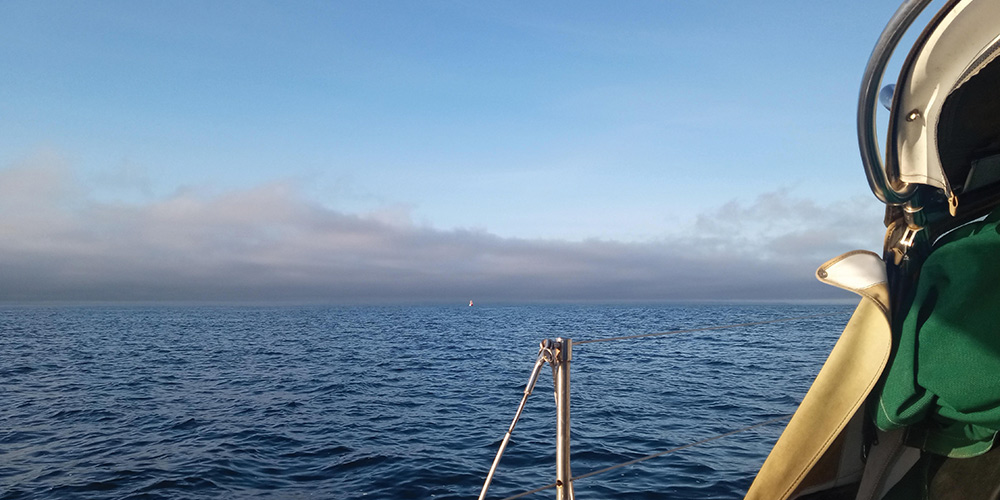
Soon, we hit the wall of fog and were running nearly blind, with only the waves coming towards us visible—we weren’t sure if we’d be able to see the winking light of the Cape Beale lighthouse in the soup. Trusting our old Garmin chartplotter and the backup downloaded nautical charts on our phone, we surged ahead in the building wind from the port bow quarter. The cruising guide warned us about the many reefs, rocks, and rips in the area, and we kept about two miles offshore. It was clearly going to be too late to make it into Ucluelet before darkness fell.
Accordingly, we decided to drop the hook in an anchorage tucked between Wouwer and Howell islands, part of the Pacific Rim National Reserve’s Broken Group. You enter the anchorage through a 500-foot gap between two tree-topped rocky outcroppings, and is described as having enough room for just one boat, with bow and stern anchor being preferable.
The slot we aimed for came into view as we sailed northeast towards the sound and it turned out to be about 200-feet wide, and was being pounded by swell breaking spectacularly against jagged rocks. Both of us were on high alert, aware that this is probably the riskiest thing we’ve tried so far on our little boat. We readied to drop the sails and Victor went on deck to muscle the mainsail in against wind now pushing 15 knots and gusting higher. At the tiller, I was alternating between neutral and giving it a bit of power to keep us moving to avoid the reefs. I was sweating under my GoreTex drysuit despite the biting wind and cold, and I could tell Victor was nervous too from the way his voice tensed as we yelled to communicate over the wind and waves.
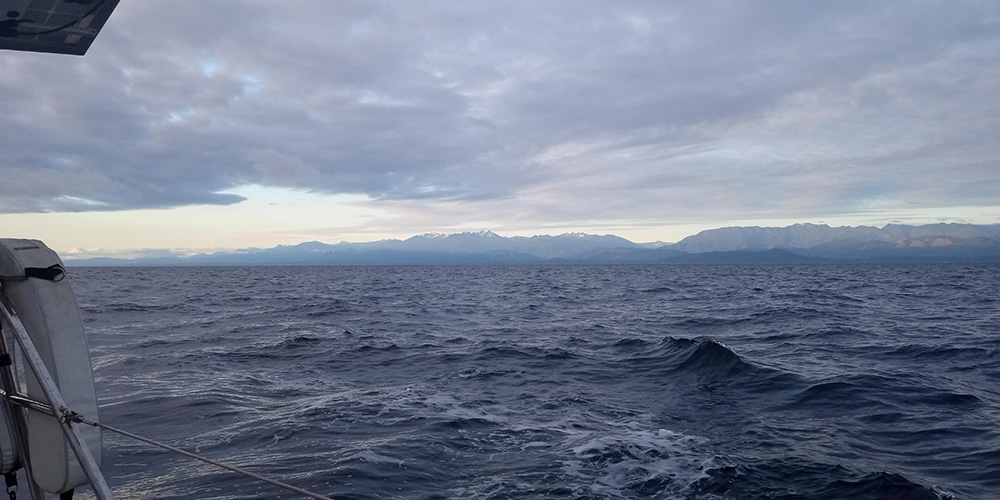
We decided to switch places, and I moved up to the bow to direct us through the slot and into the anchorage. “A little to port!”
“Now forward! More forward! Keep going forward!”
We chugged forward between the breakers, entering the surprisingly calm inlet. I could see where a reef was exposed ahead of us and to either side. Still getting the hang of positioning us in anchorages, this little gunkhole presented a good challenge. We dropped the anchor with what we thought was enough swing room and hunched nervously in the cockpit for another fifteen minutes despite our fatigue, watching Aeoli right herself into the wind. It’s a beautiful spot, remote and weather-beaten. Deciding that we were ok, we finally went down below, wind-weary and wiped, stripped out of the drysuits, and got into our sleeping bags after a half-hearted canned dinner.
The next morning, our plan was to make the crossing over to Ucluelet and pull up at the small craft harbor for a few days. We didn’t have cell service, so there was no way to call the harbormaster ahead of time to ask for specifics about how to dock and where to berth. The handheld VHF radio that we use as a backup doesn’t have the best range, either, so we weren’t counting on being able to hail anyone. “How hard could it be?” we figured.
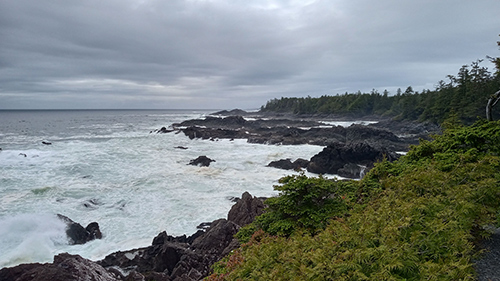
The wind carried us across the northern half of Barkley Sound to the tip of the Ucluth Peninsula, where we dropped the sails and fired up the engine for the slow chug up the narrow inlet leading to Ucluelet. I scanned the shoreline as Victor maneuvered us through the channel markers, trying to guess which of the many docks, pilings, and little inlets might be the small craft marina. “Maybe that one?” I guessed after we passed what looked like the commercial fueling docks, some private resort-looking docks, and we had nearly reached the end of the buoy-marked stretch of this little waterway. Taking our last option, we made a blind dogleg turn to port that was lined with rusting fishing boats. Victor spun Aeoli around slowly in a wide circle and we motored slowly around the bend. A jumble of masts came into view, with sailboats and powerboats leaning into the docks and into each other in this tightly packed little harbor.
I thought there should theoretically be a fuel dock where we could tie up, but I had a sinking feeling we must have already passed it. The depth was dropping at what was now low tide, and the rafted-up boats made the fairways disconcertingly narrow. In desperation, we decided to just raft up where we could and deal with moving after talking to the harbormaster. As we brought Aeoli around the finger docks, another couple happened to be aboard their boat and I yelled out, “Where should we dock?”
“Just raft up to someone with fenders out!” they replied.
“Thank you!” I called back.
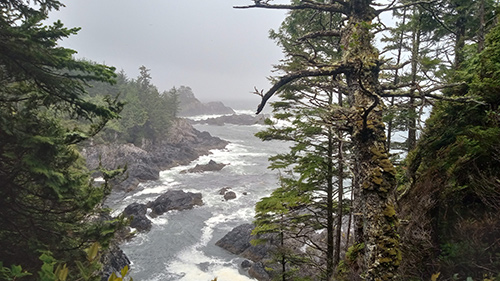
We found an algae-streaked Catalina with many fenders lining its lifelines and tried our hand at our first rafting-up experience. It took some nervous maneuvering and hasty fender-tying, but soon we were secured—as well as we could be—to our new neighbor. Luckily, it didn’t look like anyone had been on the boat for quite a while, so we didn’t feel too weird about clambering over the side decks to get to the dock.
We found the wharfinger, Kevin, just arriving at his office at the head of the dock. He welcomed us to Ucluelet and we paid the shockingly low weekly rate, planning on hunkering down until the storm had passed. Ukee, as the locals call it, is the perfect size for exploring without a car. The harbor is right in town, there’s a small but excellent grocery store, and a few restaurants and coffee shops offer a bit of variety. On top of that, there are lots of outdoor activities—bike rentals for the coastal path that winds up to Tofino, hiking all along the shoreline of the Ucluth Peninsula at the western edge of town (our offline maps helped us navigate the network of trails in the pouring rain), as well as protected surfing along the coast. You could (and we did) spend many days here.
The Wild Pacific Trail winds for about 8 km, moving into dense coastal Sitka spruce forest and out onto wind- and wave-battered rocky outcrops. A few side trails lead down to tiny pocket beaches and, at the very end, we walked around the Amphitrite Lighthouse, which has been guiding boats into Barkley Sound since 1915. By the end of our few days in Ucluelet, we’d walked this stretch of coast many times, but it never got old: the heaving sea, shifting sky, wheeling birds, and changing light kept it new every time.
When the storm finally passed, we’d stocked up on affordable Canadian food and had done our laundry in the coin-operated machines at the harbor. We stuck our nose out of the inlet to see if it was doable to cross back into the Broken Group for a few days of island hopping. The forecast called for lingering three to four meter seas, but we were going a bit stir-crazy and were ready to move again. We didn’t know what that sea state would feel like, but figured we’d give it a shot and see how we could handle it. (We could, which is a story for another day.) Still learning the limits of our skills and of Aeoli, getting to this point had felt like a great adventure—and we were ready for more!
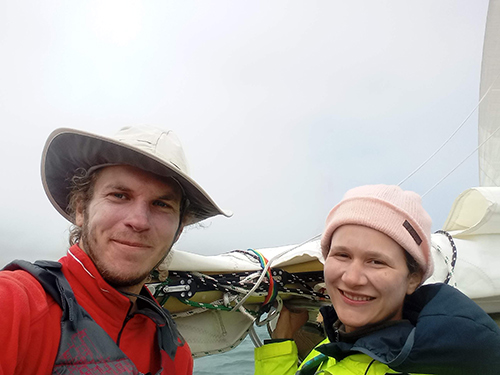
Victor and Medeea bought their first boat, Aeoli, in the winter of 2023 with the goal of going cruising full-time that summer. Together, they taught themselves to sail in the waters of Puget Sound and Canada’s Gulf Islands, explored up Vancouver Island’s west coast, and took their time working down the coast to Baja California. After a winter cruising the Sea of Cortez, they’re back in the Pacific Northwest ready to welcome a new addition to their crew! Aeoli is patiently waiting in Mexico for their return in a few months.
